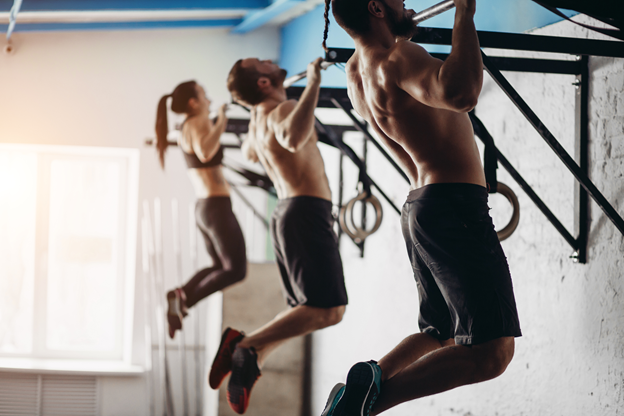For many beginners, pull-ups are the Everest of exercises, a lofty challenge that seems unattainable. But is it really as tough as it looks, or is there more to the story? Let’s dig into the grip-strength, sweat-dripping world of pull-ups and see for ourselves.
The pull-up’s reputation as a tough nut to crack isn’t all a lie, though. It’s an exercise that demands strength, patience, and a bit of grit. But, the myth that only superhumans can conquer it is just that – a myth. And it’s time to debunk it.
Oh, and let’s not forget the gender bias that sometimes creeps into the equation. There’s a peculiar notion that pull-ups are for the boys, leaving our female comrades feeling like they’re locked out of the club.
Not cool, right? In reality, pull-ups are a universal playground, a test of functional strength open to everyone.
So, in this article, we’re here to smash through the misconceptions and stereotypes. We’re giving you the lowdown on five beginner-friendly pull-up bar exercises, your trusty companions on the journey to pull-up mastery. It’s all about building up strength, boosting confidence, and proving that anyone – yes, that includes you – can embrace the pull-up bar with open arms.
So, hang on tight – we’re about to make pull-ups your new favourite challenge!
Muscles Engaged in Pull-Up Bar Exercises
Did you think it’s indeed just as simple as pulling your bodyweight upward? It is! But even pulling your entire body upward against gravitational pull requires quite a lot of strength and quite a bit of muscle work, too.
It walks almost all of your muscle groups, even the least used ones like the chest muscles. It’s an awesome move for your biceps, forearms, shoulders, back and chest.
Let me walk you through all the muscles engaged in this seemingly very simple exercise:
Left Latissimus Dorsi Muscle
First off, the left latissimus dorsi, often referred to as the “lats,” is a key player in pull-up exercises.
This broad muscle plays a pivotal role in pull-ups. As you pull your body up to the bar, your latissimus dorsi contracts and extends, making it stronger and more defined. A robust latissimus dorsi is not only essential for mastering pull-ups but also contributes to better posture, enhanced shoulder stability, and overall upper body strength.
Strengthening this muscle group also helps you achieve that coveted V-taper appearance and supports various daily activities.
The Pectoralis Major Muscle
While the pectoralis major, or chest muscle, is not the primary mover in pull-ups, it provides essential support. As you pull your body upwards, the pectoralis major stabilises your shoulders and contributes to the overall strength needed to perform pull-ups effectively.
Strong pectoralis major enhances your chest’s appearance and provides additional upper-body support.
Neck Muscles
The neck muscles help keep your head steady and aligned with your spine, preventing excessive strain on the neck.
Rotator Cuff
The rotator cuff muscles stabilise your shoulders, ensuring smooth and safe movement during pull-ups. This minimises the risk of shoulder injuries.
Flexors
The flexors in your arms and wrists assist in grip strength and control while holding onto the pull-up bar.
Forearm Muscles
Your forearm muscles, especially the brachioradialis, are actively engaged when gripping the bar, contributing to overall arm strength.
Abs
To maintain stability and prevent excessive swinging during pull-ups, your core muscles, including the rectus abdominis and obliques, are engaged. This core engagement improves overall stability and core strength.
Related article: MMA Workout To Strengthen Your Body And Biceps
How to Perform Pull-Ups Correctly?
Pull-up bar exercises may seem challenging, but when done with proper technique, they become more manageable for beginners. Here’s a step-by-step guide to performing pull-ups correctly:
- Stand facing the pull-up bar with your hands slightly wider than shoulder-width apart.
- Your palms should face away from you (pronated grip) for the standard pull-up.
- You won’t be able to pull your body up from the ground in the beginning, so grab hold of a platform, a box, or anything to stand on and reach the bar.
- Hang from the bar with your arms fully extended.
- Engage Your Back and Shoulders:
- Initiate the pull by squeezing your shoulder blades together.
- Keep your core tight and your body in a straight line.
- Exhale and pull your body upward by flexing your elbows.
- Continue pulling until your chin is above the bar.
- Focus on using your back and arms, not just your biceps.
- Inhale and slowly lower your body back to the starting position, keeping control.
- Fully extend your arms, and don’t swing or use momentum.
- Repeat
Pull-Up Bar Workout for Beginners
Exercises with pull-up bar are not those that you can master in a day or two. They take some time. They aren’t impossible but aren’t a piece of cake either, so set your mind on a gradual progression when it comes to pull-ups.
As a beginner, you’d need some easy pull-up bar exercises that help you move toward perfection. Here are some helpful variations (not all are beginner-friendly, though).
1- Chin-ups for beginners
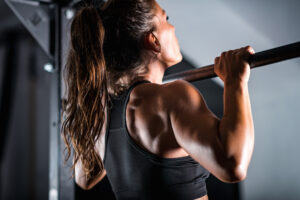
- Grip the bar with your palms facing toward you (supinated grip).
- Follow the same steps as for standard pull-ups.
- Raise your body upward until your chin is parallel to the bar or slightly above the bar.
- Return to the ground or the platform.
2- Burpee Pull-Ups
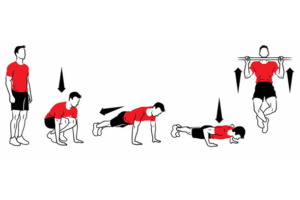
- Begin by standing a short distance in front of the pull-up bar.
- Lower your body into a squat position with your hands touching the ground.
- Kick your feet back into a push-up position, keeping your body straight from head to heels.
- Perform one push-up.
- After the push-up, jump your feet back to the squat position.
- Explosively jump up, extending your arms overhead.
- While in mid-air, reach for the pull-up bar and grab it with an overhand grip (palms facing away from you).
- As you descend from the jump and your body begins to lower, initiate a pull-up.
- Pull your chest towards the bar and aim to get your chin above the bar.
- Lower your body back down with control until your arms are fully extended.
- Repeat:
Note: This exercise requires a good level of strength and coordination, so it’s essential to start with a variation that suits your fitness level.
- If you’re a beginner, consider doing the burpee pull-up without the push-up component at first and gradually add it as you progress.
- Ensure you have a firm grip on the pull-up bar before performing the pull-up to avoid slipping or falling.
3. Knees to Elbows
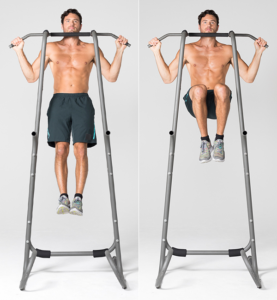
- Hang from the bar with an overhand grip (pronated).
- As you pull up, bring your knees toward your elbows.
- Engage your core to strengthen your abdominal muscles.
4. L-sits Pull Up Bar Workout
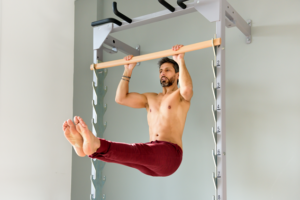
- Hang from the bar, keeping your legs straight.
- Raise your legs until they are parallel to the ground, creating an “L” shape.
- This engages your core and enhances your upper body strength.
5. Muscle Ups for Beginners
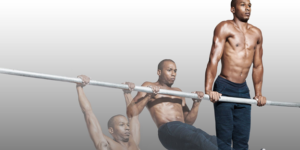
- Start with a sturdy pull-up bar or gymnastic rings.
- Begin with a strong pull-up, using momentum if necessary.
- As you reach the top of the pull-up, explosively push your body upward.
- Transition from the pull-up to a dip position above the bar.
- Lower yourself down from the dip position to complete the rep.
- Practise this transition with controlled movements until you can perform a full muscle-up.
- Gradually increase the number of muscle-ups in your workout.
Related Article: Pull-Ups vs Chin-Ups – Understanding the Variations for Better Results
Mastering Pull-Up Techniques
Maintaining proper form is crucial during pull-ups to maximise their effectiveness and prevent injuries during pull-up bar workouts for beginners. If you don’t do it correctly, you miss your mark, and it only results in sore muscles.
Here are some pull-up bar techniques to ensure proper form and avoid common mistakes:
Instead of keeping your body loose during a pull-up, you need to tighten your core muscles throughout the exercise. This stabilises your body and prevents excessive swinging or arching of the back.
A tight core feels lighter against the gravitational pull. If you are serious about mastering pull-ups, you need to work on your core strength. The stronger your core, the easier your ab workouts with the pull up bar.
Avoid using momentum to pull yourself up. You may feel the urge to just rush through it and beat your brains with speed, but it won’t work. Focus on a slow and controlled movement in both the lifting and lowering phases.
Start with your arms fully extended, you need full range of motion here, and pull yourself up until your chin is above the bar. Lower your body until your arms are fully extended again.
Ensure your grip is even, and your hands are slightly wider than shoulder-width apart. Maintain a firm grip on the bar.
Focus on engaging your back and shoulders. It’s common for beginners to rely solely on their biceps, but this can lead to poor form and potential injury.
Exhale as you pull your body up, and inhale as you lower it down. Proper breathing can help you maintain control.
It’s not going to happen in a day or two. Keep your mind fixed on gradual progress. Do it no matter what, and you’ll see your desired results pretty soon. It’s not magic, it’s science.
Like any exercise, pull-ups require practice. Be patient and stay consistent with your training to improve your form and strength over time.
Benefits of Pull-Up Bar Workouts
Pull-up bar workouts for beginners offer a wide range of benefits for your overall fitness. Here are five main pull-up benefits, along with descriptions:
1- Strengthens Upper Body Muscles
Pull-ups primarily target the muscles in your upper body, including the latissimus dorsi (back), biceps, and shoulders. As you perform pull-ups, these muscles are engaged, leading to increased strength and muscle development.
This exercise is a fundamental way to build upper body power.
2- Improves Grip Strength
Grip strength is a crucial component of many daily activities and other workouts. Pull-ups challenge your grip, leading to increased hand and forearm strength. A stronger grip can enhance your performance in various exercises and activities, such as weightlifting, rock climbing, and even carrying groceries.
3- Enhances Core Stability
Maintaining proper form during pull-ups requires you to engage your core muscles, including the abdominal and lower back muscles. As you work on your pull-up technique, you’ll strengthen your core, which is essential for stability, balance, and injury prevention.
4- Increases Functional Strength
Pull-ups are a compound exercise that mimics real-life movements like lifting, reaching, and pulling. This functional strength gained from pull-ups can improve your ability to perform everyday tasks with ease, making them a valuable addition to your fitness routine.
5- Boosts Metabolism and Fat Loss
Pull-ups are an effective compound exercise that engages multiple muscle groups. This high-intensity workout can help boost your metabolism, contributing to fat loss and improved body composition. Regular pull-up training, combined with a balanced diet, can aid in achieving weight management goals.
Conclusion
In conclusion, pull-ups, often perceived as a daunting challenge, hold immense potential for beginners willing to embark on their fitness journey. By dispelling the myths surrounding their difficulty and embracing the right techniques, anyone can master this powerful exercise. Pull-ups strengthen the upper body, improve grip strength, enhance core stability, and increase functional strength while contributing to metabolism and fat loss. With consistency, patience, and a commitment to proper form, pull-ups can become a cornerstone of your fitness regimen. So, go ahead, take the plunge, and let the pull-up bar be your path to a stronger, healthier you. The sky’s the limit, and with each successful pull-up, you’ll soar higher towards your fitness goals.

